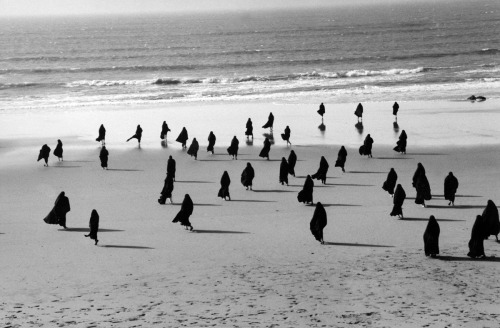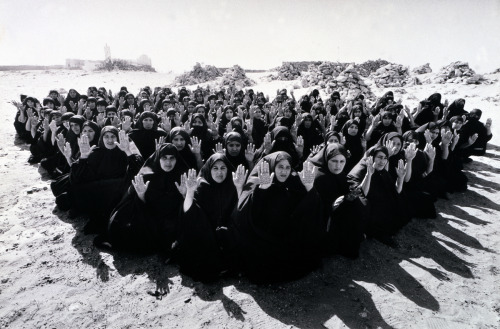Rapture Series by Shirin Neshat, 1999. Rapture consists of two projections shown on opposing g
Rapture Series by Shirin Neshat, 1999. Rapture consists of two projections shown on opposing gallery walls. One projection shows a group of men dressed alike in Western-style white shirts and black pants. The other shows a group of women wearing traditional Iranian dress, including the chador,which covers their heads and most of their bodies, and in some cases, the niquab, a face covering. Despite these garments, the viewer is able to decipher individual features and expressions. The installation, which is 13 minutes long and shown in continuous loops, shows elegiac and meditative scenes of the two groups. As the women traverse landscapes of sand and stone, the men navigate the stone architecture of an ancient city. As the women cry out—whether in celebration or anger, it’s unclear—the men unroll Persian prayer rugs and quarrel. In the final scene, the women gather on a beach, where they maneuver a small boat into the crashing waves. As their bare feet break the sand surface, the hems of their chadors become wet with salt water. Ultimately, six women remain in the boat as it drifts out to the sea. Although art historians reference Neshat’s upbringing in Iran and her experiences in the United States as a way to shed light on her body of work, Neshat herself is neither dogmatic nor clear about her intentions. “From the beginning,” she said in a 1999 interview with art critic Arthur Danto, “I made a decision that this work was not going to be about me or my opinions on the subject, and that my position was going to be no position. I then put myself in a place of only asking questions but never answering them.” [x] -- source link
Tumblr Blog : noiseman-blog.tumblr.com
#photography#shirin neshat#video installation#visual art#contemporary


